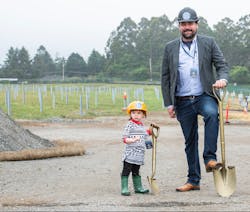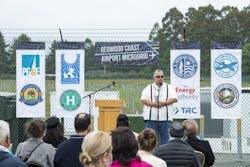After scaling multiple development feats, the Redwood Coast Airport Microgrid — California’s first 100% renewable, front-of-the-meter microgrid — has begun construction.
The 2.25-MW solar-based microgrid in Humboldt County on California’s northern coast is a model for the state and the country, US Rep. Jared Huffman, D-Calif., said July 7 at the microgrid’s groundbreaking.
“Our 20th century infrastructure is just no longer up to the task of providing power to many communities in the 21st century,” Huffman said. “We’ve got extreme heat, wind driven wildfires, water shortages. Increasingly, we’re concerned about the condition of our roads, bridges and airports, and the playbook on infrastructure really has to get rewritten.”
Huffman plans to take his knowledge of the Redwood Coast Airport Microgrid back to Washington, DC, where he is a co-sponsor of the Utility Resilience and Reliability Act, which he said would bolster California’s electrical infrastructure against disasters and public safety power shutoffs.
Microgrid can run two weeks in island mode
The microgrid, which will typically be able to run for two weeks in island mode, will serve 20 customer meters, including the Arcata-Eureka Airport and a US Coast Guard Air Station. The project includes a 2.2-MW, 8.8-MWh battery storage system and electric vehicle chargers that can be used for demand response.
Set to be running by the end of the year, the microgrid was designed by the Schatz Energy Research Center at Humboldt State University. The project will be owned by the Redwood Coast Energy Authority, a community choice aggregator (CCA), and will run on Pacific Gas & Electric (PG&E) power lines.
The Redwood Coast Airport Microgrid is designed to provide energy resilience for Humboldt County’s regional airport, which is used for emergency services and medical life flights, as well as the neighboring US Coast Guard Air Station, which runs search and rescue missions for 250 miles of rugged coastline.
The California Energy Commission helped fund the project with a $5 million grant from its EPIC program. The US Department of Agriculture (USDA) provided a $6.6 million loan.
This will be the first microgrid to participate in the California Independent System Operator’s wholesale electricity market, which will help defray the cost of the system.
Are you investigating a microgrid for your California facility? Learn what you need to know at Microgrid California, an educational forum hosted by Microgrid Knowledge Oct. 5 in Foster City, California.
Project overcomes major challenges
The project faced significant challenges, according to Matthew Marshall, Redwood Coast Energy Authority executive director.
Referring to a line from “The Princess Bride” movie, Marshall said the microgrid project fell victim to a classic blunder, noting that the most famous is engaging in a land war in Asia.
“But second only to that is building the first ever DC coupled, front-of-the-meter, multicustomer microgrid, in collaboration with a CCA and an investor owned utility, and then use USDA financing for the first CCA project as well as the first microgrid that they’ve ever financed,” Marshall said. “And they’re doing that at an airport in the middle of a global pandemic. So, you know, there’ve definitely been a lot of steps to get to this point.”
While the project is technically innovative, the collaboration between PG&E, the Redwood Coast Energy Authority and the Schatz Energy Research Center is also innovative, allowing them to create something they couldn’t have individually, according to Marshall.
Redwood Coast Airport Microgrid helps guide CPUC
The microgrid has helped inform the California Public Utilities Commission (CPUC)’s efforts to craft new rules to spur microgrid development, according to CPUC Commissioner Darcie Houck.
The project was critical for the development of the standard multiproperty microgrid tariff, which the commission will consider in an upcoming track of its overall microgrid proceeding, Houck said.
“The tariffs and agreements developed here will become important examples to other [investor-owned utilities] and CCAs that may want to replicate this business model,” Houck said. “I also appreciate that this project aims not only to increase local resiliency but also to increase load flexibility by incorporating electric vehicle charging that is demand response capable. Making customer demand more flexible is a critical step in the transition to a cleaner grid.”
Airport microgrid helps PG&E develop policies, tariffs
Ted Hernandez, Wiyot Tribe tribal chair, speaking at Redwood Coast Airport Microgrid groundbreaking. Photo courtesy of Humboldt State University.
The project has helped PG&E develop its microgrid policies and tariffs, according to Ron Richardson, the utility’s regional vice president for California’s north coast region.
Before the airport project, PG&E was a partner on the Blue Lake Rancheria microgrid, which was spearheaded by the Schatz Energy Research Center.
It is through these microgrid projects that PG&E has been able to develop the right policies and tariffs, the operating procedures and technology needed for scaling the deployment of multicustomer microgrids in California,” Richardson said.
PG&E intends to replicate the Redwood Coast Airport Microgrid, partly through its recently launched Community Microgrid Enablement Program, Richardson said.
Additional microgrids in the works
The Schatz Energy Research Center, the Blue Lake Rancheria, a Native American tribe and the Redwood Coast Energy Authority said they were looking at how energy demand in an interconnected microgrid system can respond to the needs of the utility grid.
“The Redwood Coast Energy Authority seeks to follow the airport project with a network of community microgrids and renewable backup power systems that can help manage disruptions within the rural energy supply,” Marshall said.
Track news about the progress of the Redwood Coast Airport Microgrid. Subscribe to the free Microgrid Knowledge Newsletter.








